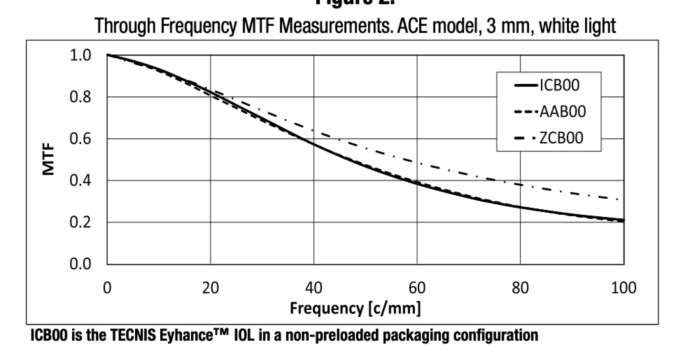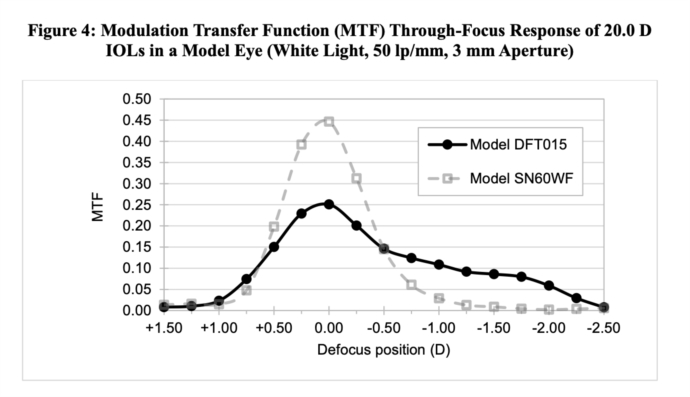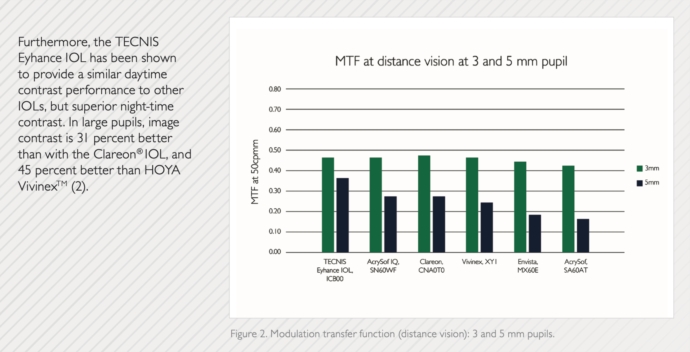Contrast Sensitivity – Vivity vs. Eyhance vs. Tecnis (ZCBOO) vs. Arysof (SN60WF)
Posted , 13 users are following.
I was interested in Vivity but the warning about Contrast Sensitivity concerned me. So I started looking into Eyhance. It's very difficult to compare IOL metrics since the data comes from all difference sources and often uses different testing configurations. And some data can only be sourced if you're a researcher or pay money for a paper. But I think I have it figured out. Here are some of my sources:
.
Eyhance Specs from J&J
Go to jnjvisionpro and look in Products > Eyhance for a spec sheet with a defocus curve and graph of Through Frequency MTF Measurements. ACE model, 3 mm, white light graph (below)
FDA approval PDF for Vivity (Page 8)
Search on "P930014S126B" but only at 50 lp/mm and only for a 3mm (daylight conditions) pupil.
Eyhance Whitepaper from The Optomologist dotcom
Search on "Delivering intermediate vision the new tecnics eyhance monofocal iol"
There seem to be two ways to test Contrast Sensitivity, a lab test using an "ACE" model eye and actual people in a room looking at a chart trying to make out patterns of vertical lines. The former lp/mm units(?). The latter uses lines per degree. I managed to find data for all 4 lenses mentioned in the subject of this thread for the first kind of test (lp/mm). This is what I found. Sometimes I'm guessing at these numbers based on a visual graph.
.
MTF 50 lp/mm at distance
.
3mm (day)
Tecnis: 0.56
Acrysof: 0.46
Eyhance: 0.46
Vivity: 0.25
.
5mm (night)
Tecnis: 0.42
Eyhance: 0.36
Acrysof: 0.28
Vivity: ???
.
Vivity did OK in second kind of test (people in a room reading a chart) in binocular mesopic conditions. You can find that data in the FDA PDF as well as a presentation that you can find by searching on "Cathleen Mccabe ISO presentation". The presentation says the CS loss in binocular mesopic conditions is not "clinically significant" but it still concerns me.
.
For discussion... should these lab-based measurements (using an ACE model eye) be taken with a grain of salt? Am I making myself crazy over nothing? Is it better to just focus on real world results and patient testimonials?
.
If any of my numbers are wrong or if anyone finds more or better data please reply.
1 like, 41 replies



Guest
Edited
Interesting FYI. I just watched a webinar on Vimeo called "Move Presbyopia Correction Forward with AcrySof® IQ Vivity®".
.
First of all huge thanks to the ophthalmologist named Gerald in that video for being the first and only ophthalmologist I've ever seen bring up the somewhat troubling MTF plot from the FDA paper. It gets tiring (and suspicious) to only ever see cheerleading from surgeons. Nice to see some scientific skepticism. He pointed out that maybe a very fussy patient might notice an effect from that poor MTF result or it may be a reason to think twice about Vivity in someone with some pathology. However he echoed the comments that I'm hearing everywhere that patients in real life (in their practices) are very happy and no is complaining about image quality. But it is something to consider.
.
The really interesting thing that Gerald added though was a slide about areas for improvement. He mentioned more range would be nice and a T2 (don't know what that is) and also that he'd prefer to have Vivity on the new Clareon platform. This is at about the 45 min mark. The really interesting tidbit is that the moderator then says that Alcon WAS planning to release Vivity on the Clareon platform but didn't because of a delay with Clareon approvals. And presumably it WILL move to the Clareon platform at some point. Although she didn't mention a timeline. I assume with both Clareon and Vivity now approved that it wouldn't be a lengthy progress to get that new version to market? But who knows.
.
The main benefit of Clareon is that it uses a new material which is classified as glistening-free and having "superior clarity" (although I could not find any quantifying data on that claim). It also reduces the incidence of PCO. Very interesting. I'm wondering if this new material will improve the MTF bench data? As a 50-something patient I am a little concerned about glistening with the Acrysof material. And with contrast in case there is any ocular pathology in my future. This IOL would have to suit me for may decades to come assuming I live that long.
RonAKA Guest
Edited
I found an interesting article on the Clareon material. Should be able to find it by googling this:
.
The Ophthalmologist Oct 9, 2017 Clareon® IOL: A New Monofocal Platform pdf
.
It is an Alcon produced document so all positive of course. It sounds like it has some interesting design feature improvements with respect to the edges which may be helpful in reducing the potential for dysphotopsia to those that experience those issues -- perhaps younger people with larger pupil sizes. The other interesting feature I saw was a comparison in the shape of the lens. We are always told that the lens is 6 mm in almost all lenses. However, I came across a claim in another article that some manufacturer don't really use all that diameter due to a thicker area near the edge which is not part of the optics. This graphic from the article illustrates it. This also may be an important factor for those that are younger with larger pupil sizes. The Tecnis and en Vista lenses seem to suffer from this the most.
.
.
This may be more of an issue with those that are far sighted than those that are near sighted.
.
On the material improvement, I have to remain a bit skeptical about it. The refractive index is unchanged at 1.55. This means that the potential for chromatic aberration will be unchanged. The asphericity of -0.2 is unchanged so it under corrects like they always have, and believe is the right amount. Together I suspect the material will test the same on the MTF simulation test as that test is impacted by the asphericity and chromatic aberration. The material retains the UV and blue light filter, so that is unchanged as well. Alcon has long battled the claim that their AcrySof material is more susceptible to glistenings. They have long claimed it was a quality control issue and they have fixed it, but the claims from the competition continue. I wonder if they would be as devious as to not change anything about the material except for the name? I don't see anything different about the material except for the claim of improved manufacturing quality control. That is the same claim they make about the AcrySof material...
.
I see that this material became widely available in Canada in February 2021, so it is still pretty new, but appears to have been around in Europe for 4 years or so... That also seems a bit strange. I get the feeling that this is a bit of a bundle of very small product refinements that they decided it would be worth a new name.
.
For sure I will ask about it when my wife's appointment comes up to see what the surgeon says about it. As always one wants to see real world experience to avoid any bleeding edge issues.
Guest RonAKA
Edited
No it is in fact a new material. It has a higher water content. And it has been tested in the lab for glistening. There are specific criteria an IOL has to pass in order to be labelled as glistening-free and the Clareon did pass those tests and has been "awarded" the glistening-free label. Easy to find a lot of information on this with a google search of your choice but this PDF in a simple short summary with pictures: search on 5b225e97da50f
.
The other claim is just "unsurpassed clarity" but that's never quantified in any way. I suspect that is just about the surface finish. And you're right that without a change to it's filtering, spherical aberration correction and chromatic aberration reduction the MTF probably would remain unchanged. Still all the other little improvements would be a nice addition to the Vivity.
.
Interesting side note, If you google Clareon Vivity you'll see that was trademarked last summer.
Guest
Posted
Ok been doing more research on glistenings and searching on "Glistening through the years" yields a great little bit of research. It backs up Alcon's ongoing claims through the years and decades to have continually improved on the issue… and also that the Clareon is essentially glistening-free. But it looks like it was a real problem in the 90s. Bottom line is that I don't think it's anything to worry about in the latest Acrysof lenses.
RonAKA Guest
Edited
Yes, I found a study which conclude that. A quote:
"The mean number of MV was highest in the 1990s-manufacture Alcon acrylic IOLs, with 1289 (± 738) MV/mm2. The number decreased to 650 (± 101), 192 (± 105), 175 (± 112) and 47 (± 26) for MA60AC, SA60AT, TFNT00 and SN60WF, respectively. The lowest count was obtained in the Clareon group, with 1 (± 1) MV/mm2."
Lunabug RonAKA
Posted
Hi, I just came across this thread and wanted to ask about the refractive index - will Vivity lenses cause cat eye reflections at this index? I am told all Alcon lenses do because of the higher refractive index number. Tecnis seems closer to the natural lens index. It just seems like surgeons are not informing patients of this potential side effect, which for me would be enough to probably avoid an Alcon lens.
RonAKA Lunabug
Posted
I have an Alcon AcrySof IQ lens in one eye. I am not sure what you mean by cat eye reflections? The vision looks totally normal to me. I see much better with it than I do with my other eye which still has a mild cataract. The refractive index is said to be a potential cause of positive dysphotopsias, but there is not universal agreement on that. I have no visual effects that I can attribute to the lens.
Guest RonAKA
Edited
I think he may be referring to an effect that other people may see when looking at your eyes?
RonAKA Guest
Posted
Not sure what other people see, but I can't see any difference between the IOL eye and the other natural eye. Look the same to me.
Lunabug Guest
Edited
Correct, and I'm a she. : )
Lunabug RonAKA
Posted
The high index lenses, like 1.55 and above, cause cat eye reflections visible to others. The human lens index is around 1.41 so IOLs closer to that number dont generate the reflections. I was told by an eye surgeon all of Alcon's lenses have a high index and therefore will generate the glinting within the eye. Interesting to hear you do not experience this effect!
Guest Lunabug
Posted
Opps. Sorry.
RonAKA Lunabug
Posted
You may be referring to "glistenings". They have nothing to do with the refractive index of the lens material. They are caused by very tiny voids in the material that fill up with fluid over time. The Alcon material has been susceptible to them but they blame it on early quality control issues in the manufacture, which they now say have been resolved. My surgeon says he has occasionally seen them but in his practice they have never had an impact on the vision of the patient. I really don't think they are visible to other people, and you need an optometrist slit lamp to see them in the lens. Alcon have recently come out with a newer material used in their Clareon lens which are just being released and may be hard to find. They claim a number of improvements with absence of glistenings being one of them. My opinion is that it is just a marketing issue. Tecnis and others like to point to Alcon and say they have a glistening problem when the problem is not really clinically significant. I have no regrets getting an Alcon Acrysof lens. For me it was a choice between Alcon and Tecnis, and I picked the Tecnis. I like the fact that they use a blue light filter to give a more accurate colour profile.
RonAKA Lunabug
Posted
The other possibility is that you are talking about PD. It has been blamed on a higher refractive index although there are studies which dispute that claim. Here is an abstract of one that compared the two possible choices I had when I had my surgery.
Refractive index and its impact on pseudophakic dysphotopsia
Purpose
It has been shown that the biggest dissatisfier for uncomplicated cataract surgery patients is pseudophakic dysphotopsia (PD). While edge design of an intraocular lens (IOL) impacts this problem, refractive index is still controversial as to its impact. This retrospective cohort study was designed to determine the role of increasing refractive index in PD.
Patients and methods
This study was conducted at the John A. Moran Eye Center, University of Utah, USA. A retrospective chart review identified patients who received one of two hydrophobic acrylic single piece IOLs (AcrySof WF SP SN60WF or Tecnis SP ZCB00), which differed mainly by refractive index (1.55 versus 1.47). Eighty-seven patients who had received implantation of a one-piece hydrophobic acrylic IOL were enrolled. Patients were included if the surgery had been uncomplicated and took place at least a year before study participation. All eligible patients had 20/20 best corrected vision, without any disease known to impact visual quality. In addition to conducting a record review, the enrolled patients were surveyed for PD, using a modified National Eye Institute Visual Function questionnaire, as well as for overall satisfaction with visual quality.
Results
Statistical analysis demonstrated no difference between the two cohorts regarding PD, general visual function, and overall visual satisfaction.
Conclusion
The study suggests that with the two IOLs assessed, increasing the refractive index does not increase incidence of PD or decrease overall visual satisfaction.
Guest RonAKA
Edited
Correct my if I'm wrong Lunabug but no, not glistenings or dysphotopsia… quite simply your eyes looking different than before because people can see the IOL… I believe it's like a white reflection from the IOL. It's a known issue. Most people are not concerned about it and I suspect surgeons rarely if ever even mention it. But if it's and issue to you then it's and issue. The Tecnis platform and silicone IOLs apparently do not cause this effect while the Acrysof platform does.
.
You should test it out Ron. Look in the mirror with a bright light and see if you can see a difference in the appearance of your two eyes.
lucy24197 Lunabug
Posted
There's an older thread that talks about this. Search/google on '"Concerns about Alcon Acrysoft IOL" patient.info' and you should see it. There's a discussion of this effect. (I've also heard it called "diamond eye.") It sounds like it's purely cosmetic and only happens rarely when the light is exactly right--you can see a reflection off the IOL. One person was able to include a photo. Personally I think it's kind of cool. Regardless, it doesn't sound like it affects your vision.
RonAKA Guest
Posted
I checked my eyes, and I can't see the contact lens in my left eye, or the IOL in my right eye. I know the contact has a slight blue tint, and the IOL a slight yellow tint, but I can't see either one in my eyes.
Night-Hawk RonAKA
Posted
I think the effect is from a reflection of a light in the eye, so probably requires a special light setup, most of the time you wouldn't see a difference in reflection between the eyes and its hard to see by yourself - have to ask other people.
RonAKA Night-Hawk
Posted
I am not concerned. I consider it a non issue and frankly I have never heard of it before.
Night-Hawk RonAKA
Posted
Yep its just a cosmetic effect in any case.
Lunabug Guest
Posted
Correct. The lens causes the eye to flash similar to a cat's eye when the light strikes from a particular position.
Lunabug lucy24197
Posted
Any high refractive IOL can cause the diamond eye effect. It's more noticeable in people with larger pupils. It doesn't seem to affect vision but I personally don't want that as a side effect if i can avoid it.
RonAKA Lunabug
Posted
What is your source of this "cat eye" effect information? I will say again in all the research I have done on IOLs I have never seen anything about it.